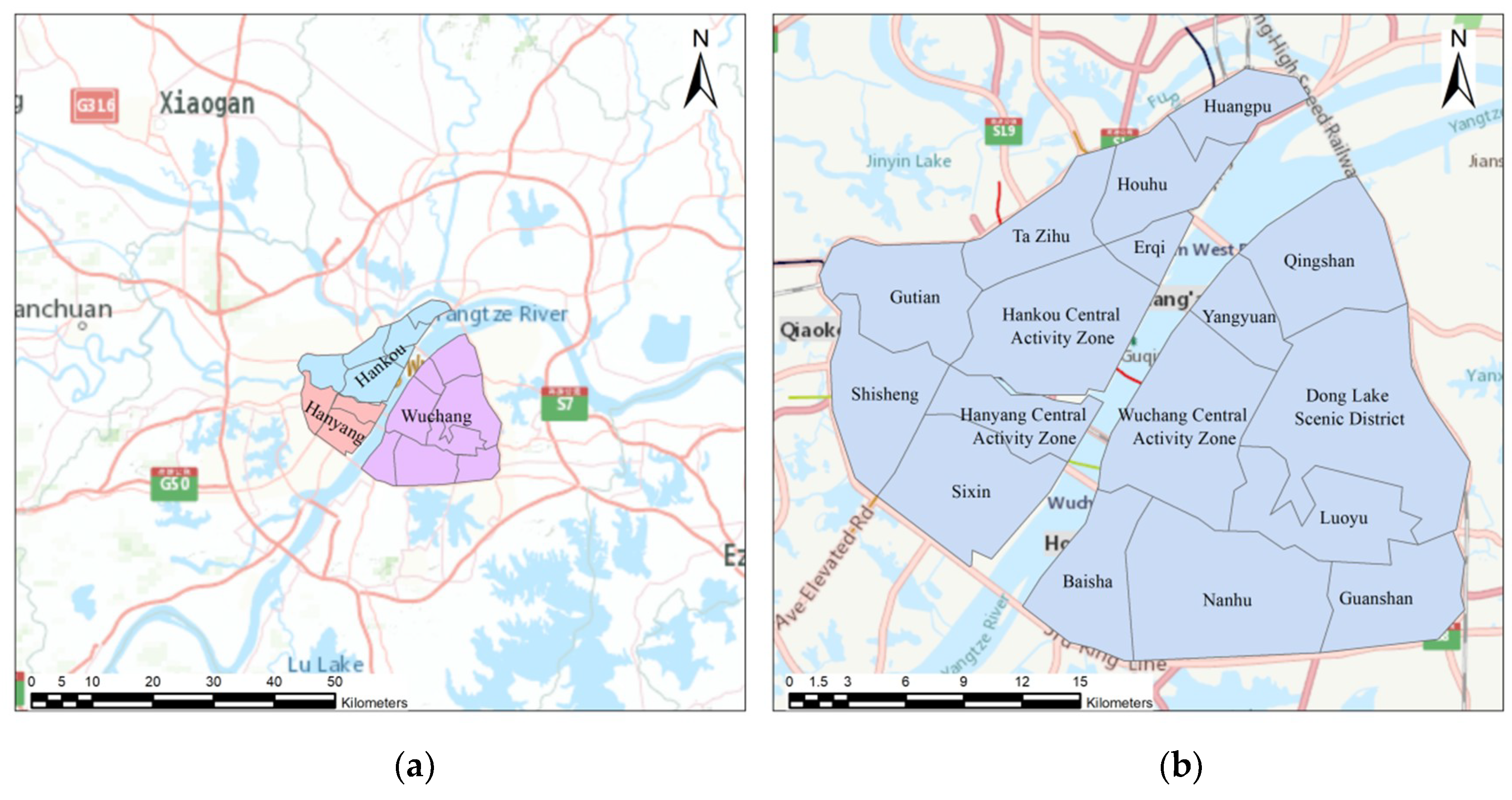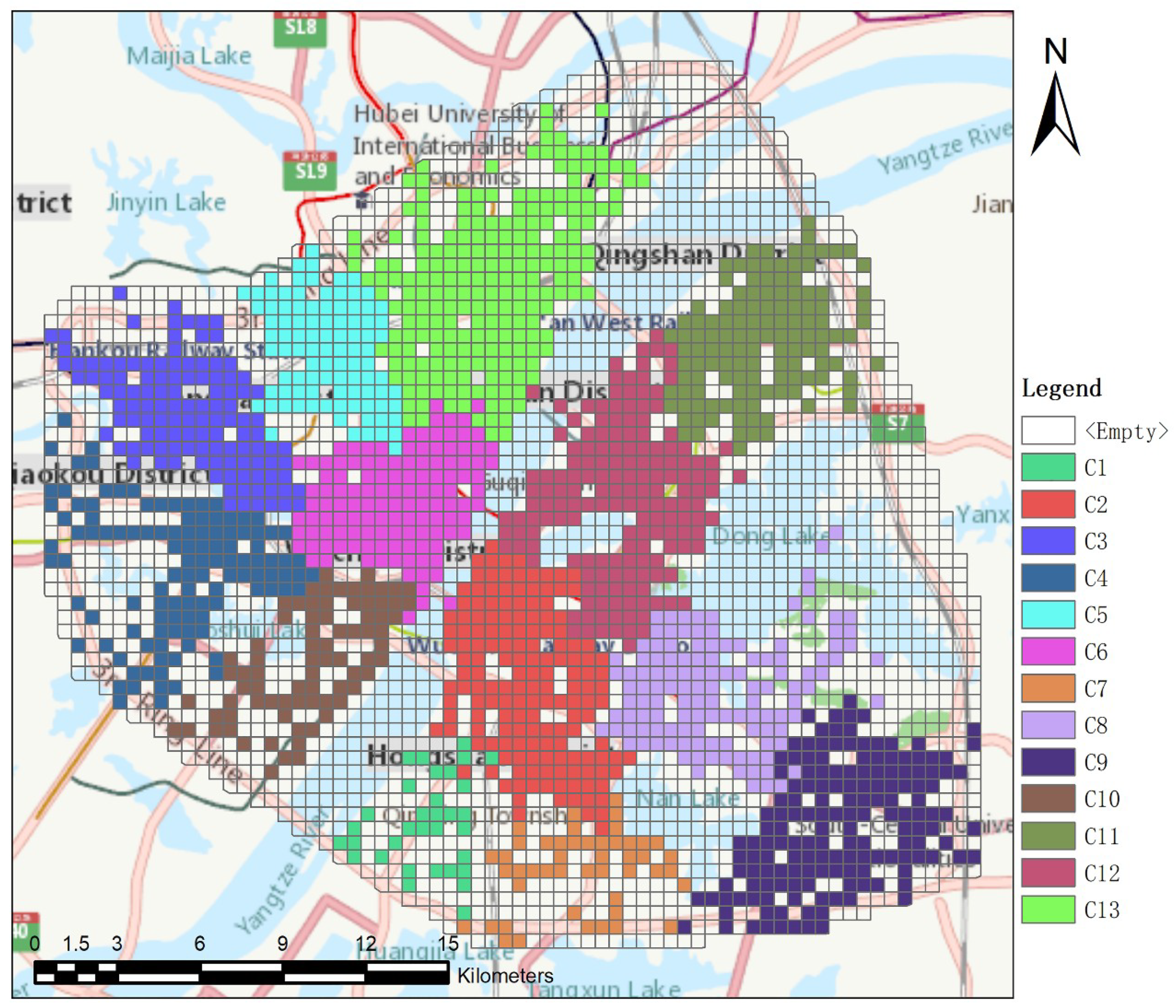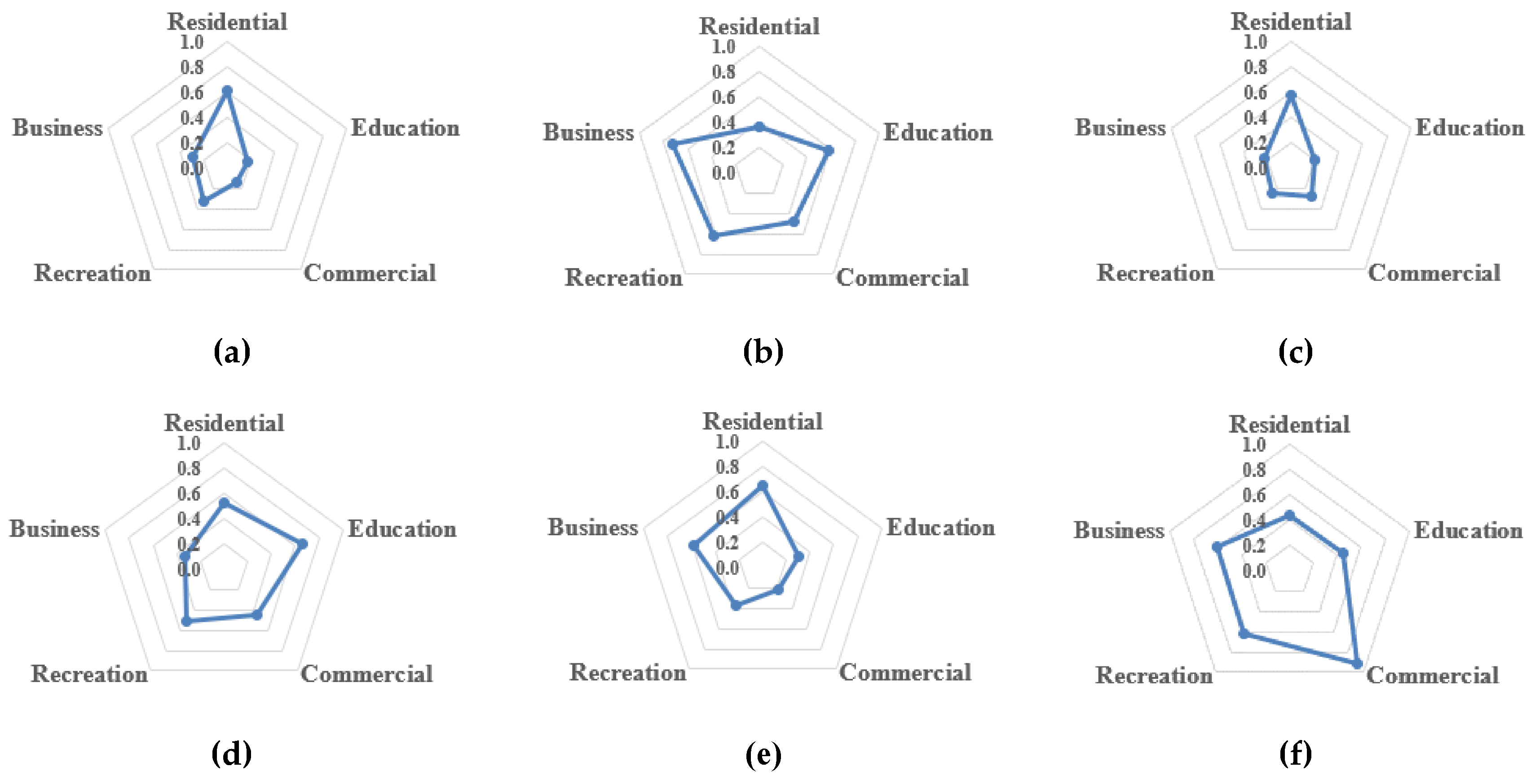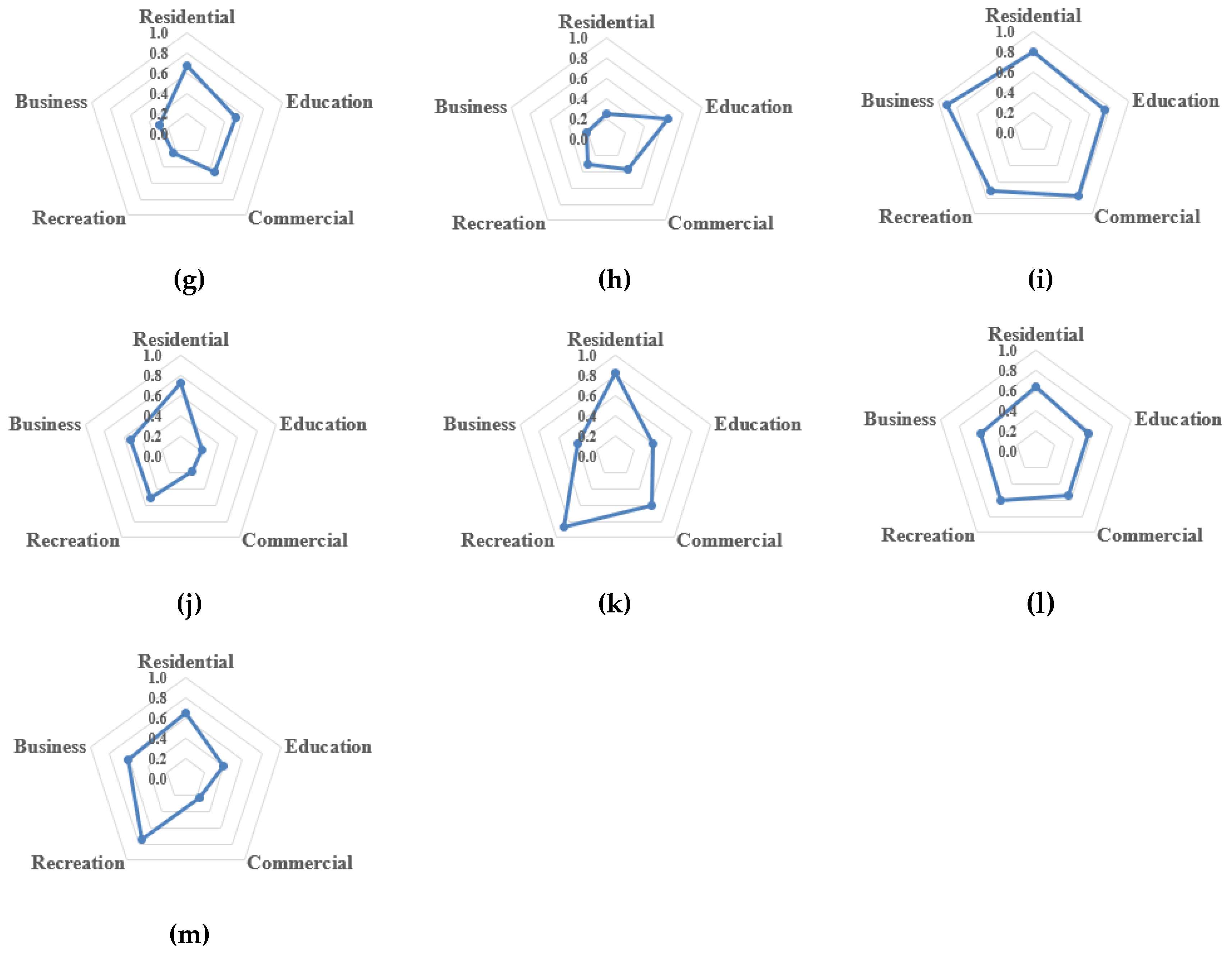Detecting and Evaluating Urban Clusters with Spatiotemporal Big Data
Abstract
1. Introduction
2. Related Work
3. Methodology
3.1. Detection of Urban Clusters from Daily Travel Space of Urban Residents
3.1.1. Determining the Grid Cell Size
3.1.2. Measuring Daily Travel Space of Urban Residents
3.1.3. Detecting Urban Clusters
3.2. Quantitative Analysis and Evaluation of Urban Clusters
3.2.1. Acquiring Resident Demands for Land-Use Functions Based on Inferred Activity Types
- {1, 2, 3,…, n} is the well-divided gird set in which n denotes the grid cell number.
- {0:00–8:00, 8:00–10:00, 10:00–12:00, 12:00–14:00, 14:00–16:00, 16:00–18:00, 18:00–20:00, 20:00–22:00, 22:00–24:00} is the timeline in which the day is divided into nine intervals.
- {workdays, weekends} is the day set.
3.2.2. Evaluating the Rationality of Land-Use Functions in the Detected Clusters
3.2.3. Evaluating Conformance between Detected Clusters and Planned Clusters
4. Implementation and Results
4.1. Study Area and Dataset
4.2. Detecting and Evaluating Single-Temporal Urban Clusters
4.2.1. Comparing Detected Results with Planned Clusters
4.2.2. Comparing the Differences in Land-Use Functions of the Three Towns of Wuhan
4.3. Quantitatively Evaluating Progress of Urban Cluster Construction
5. Conclusions
Author Contributions
Funding
Acknowledgments
Conflicts of Interest
References
- Hu, X. Analysis on the Impact of Urban Clustered Land Use on Resident Travel Spatial Distribution—A Case Study of Changzhou City. Urban Roads Bridges Flood Control 2016, 2016, 4–7. [Google Scholar]
- Li, J.; Shi, J.; Wu, Z. Analysis on the Change Tendency of Group City’s Residential Trip Characteristics. J. Trans. Syst. Eng. Inf. Technol. 2008, 6, 70–75. [Google Scholar]
- Wan, X.; Chen, J.; Wang, W. Analysis the car trip characteristics of clustered city. Urban Plan. Forum 2007, 3, 86–89. [Google Scholar]
- Fang, K.; Wang, W.; Lu, J. Group City’s Resident Trip Time Consume Characteristic. J. Trans. Eng. Inf. 2005, 32, 92–96. [Google Scholar]
- Zou, D. Introduction to Urban Planning; China Architecture & Building Press: Beijing, China, 2011. [Google Scholar]
- Xu, Y.; Shaw, S.L.; Zhao, Z.; Yin, L.; Lu, F.; Chen, J.; Fang, Z.; Li, Q. Another Tale of Two Cities: Understanding Human Activity Space Using Actively Tracked Cellphone Location Data. Ann. Am. Assoc. Geogr. 2016, 106, 489–502. [Google Scholar]
- Lu, C.; Yang, Q.; Jin, D.; Li, X.; Wen, F. Research Progress and Prospects of the Researches on Urban Land Use Structure in China. Prog. Geogr. 2010, 29, 861–868. [Google Scholar]
- Tang, L.; Kan, Z.; Zhang, X.; Sun, F.; Yang, X.; Li, Q. A network kernel density estimation for linear features in space–time analysis of big trace data. Int. J. Geogr. Inf. Sci. 2016, 30, 1717–1737. [Google Scholar] [CrossRef]
- Niu, N.; Liu, X.; Jin, H.; Ye, X.; Liu, Y.; Li, X.; Li, S. Integrating multi-source big data to infer building functions. Int. J. Geogr. Inf. Sci. 2017, 31, 1871–1890. [Google Scholar] [CrossRef]
- Caceres, N.; Benitez, F.G. Supervised land use inference from mobility patterns. J. Adv. Trans. 2018, 2018, 8710402. [Google Scholar] [CrossRef]
- Widhalm, P.; Yang, Y.; Ulm, M.; Athavale, S.; González, M.C. Discovering urban activity patterns in cell phone data. Transportation 2015, 42, 597–623. [Google Scholar] [CrossRef]
- Soto, V. Automated land use identification using cell-phone records. In Proceedings of the 6th ACM International Workshop on Mobiarch, New York, NY, USA, 28 June–1 July 2011; pp. 17–22. [Google Scholar]
- Lu, F.; Liu, K.; Chen, J. Research on Human Mobility in Big Data Era. J. Geo-Inf. Sci. 2014, 16, 665–672. [Google Scholar]
- Tu, W.; Cao, J.; Yue, Y.; Shaw, S.L.; Zhou, M.; Wang, Z.; Chang, X.; Xu, Y.; Li, Q. Coupling mobile phone and social media data: A new approach to understanding urban functions and diurnal patterns. Int. J. Geogr. Inf. Sci. 2017, 31, 2331–2358. [Google Scholar] [CrossRef]
- Liang, N.; He, Z.; Miao, J. Spatiotemporal characterization of user behaviors based on micro-blog data mining. Sci. Surv. Map. 2016, 41, 34–39. [Google Scholar]
- Encalada, L.; Boavida-Portugal, I.; Cardoso Ferreira, C.; Rocha, J. Identifying Tourist Places of Interest Based on Digital Imprints: Towards a Sustainable Smart City. Sustainability 2017, 9, 2317. [Google Scholar] [CrossRef]
- Kuo, C.; Chan, T.; Fan, I.; Zipf, A. Efficient Method for POI/ROI Discovery Using Flickr Geotagged Photos. ISPRS Int. J. Geo-Inf. 2018, 7, 121. [Google Scholar] [CrossRef]
- Crooks, A.; Pfoser, D.; Jenkins, A.; Croitoru, A.; Stefanidis, A.; Smith, D.; Karagiorgou, S.; Efentakis, A.; Lamprianidis, G. Crowdsourcing urban form and function. Int. J. Geogr. Inf. Sci. 2015, 29, 720–741. [Google Scholar] [CrossRef]
- Spek, S.V.D.; Schaick, J.V.; Bois, P.D.; Haan, R.D. Sensing human activity: GPS tracking. Sensors 2009, 9, 3033–3055. [Google Scholar] [CrossRef] [PubMed]
- Song, C.; Qu, Z.; Blumm, N.; Barabasi, A.L. Limits of predictability in human mobility. Science 2010, 327, 1018–1021. [Google Scholar] [CrossRef] [PubMed]
- Li, T.; Pei, T.; Yuan, Y.; Song, C.; Wang, W.; Yang, G. A review on the classification, patterns and applied research of human mobility trajectory. Prog. Geogr. 2014, 33, 938–948. [Google Scholar]
- Jin, Y.; Batty, M. Applied urban modeling: New types of spatial data provide a catalyst for new models. Trans. GIS 2013, 17, 641–644. [Google Scholar] [CrossRef]
- Batty, M. Big data, smart cities and city planning. Dialogues Hum. Geogr. 2013, 3, 274–279. [Google Scholar] [CrossRef] [PubMed]
- Mou, N.; Zhang, H.; Chen, J.; Zhang, L.; Dai, H. A Review on the Application Research of Trajectory Data Mining in Urban Cities. J. Geo-Inf. Sci. 2015, 17, 1136–1142. [Google Scholar]
- Calabrese, F.; Reades, J.; Ratti, C. Eigenplaces: Segmenting space through digital signatures. IEEE Pervasive Comput. 2009, 9, 78–84. [Google Scholar] [CrossRef]
- Burian, J.; Brychtová, A.; Vávra, A.; Hladišová, B. Analytical material for planning in Olomouc, Czech Republic. J. Maps 2016, 12, 649–654. [Google Scholar] [CrossRef]
- Xie, Y.; Fang, C.; Lin, G.C.S.; Gong, H.; Qiao, B. Tempo-spatial patterns of land use changes and urban development in globalizing China: A study of Beijing. Sensors 2007, 7, 2881–2906. [Google Scholar] [CrossRef]
- Pei, T.; Sobolevsky, S.; Ratti, C.; Shaw, S.L.; Li, T.; Zhou, C. A new insight into land use classification based on aggregated mobile phone data. Int. J. Geogr. Inf. Sci. 2013, 28, 1988–2007. [Google Scholar] [CrossRef]
- Gong, L.; Liu, X.; Wu, L.; Liu, Y. Inferring trip purposes and uncovering travel patterns from taxi trajectory data. Cartogr. Geogr. Inf. Sci. 2015, 43, 103–114. [Google Scholar] [CrossRef]
- Soto, V.; Frías-Martínez, E. Robust Land Use Characterization of Urban Lanscapes using Cell Phone Data. In Proceedings of the First Workshop on Pervasive Urban Applications, San Francisco, CA, USA, 12–15 June 2011; pp. 1–8. [Google Scholar]
- Frias-Martinez, V.; Soto, V.; Hohwald, H.; Frias-Martinez, E. Characterizing Urban Landscapes Using Geolocated Tweets. In Proceedings of the IEEE International Conference on Privacy, Security, Risk and Trust, Amsterdam, The Netherlands, 3–5 September 2013; pp. 239–248. [Google Scholar]
- Toole, J.L.; Ulm, M.; González, M.C.; Bauer, D. Inferring land use from mobile phone activity. In Proceedings of the ACM SIGKDD International Workshop on Urban Computing, Beijing, China, 12 August 2012; pp. 1–8. [Google Scholar]
- Chen, Y.; Liu, X.; Li, X.; Liu, X.; Yao, Y.; Hu, G.; Xu, X.; Pei, S. Delineating urban functional areas with building-level social media data: A dynamic time warping (DTW) distance based k-medoids method. Landsc. Urban Plan. 2017, 160, 48–60. [Google Scholar] [CrossRef]
- Wang, Y.; Wang, T.; Tsou, M.H.; Li, H.; Jiang, W.; Guo, F. Mapping dynamic urban land use patterns with crowdsourced geo-tagged social media (Sina-Weibo) and commercial points of interest collections in Beijing, China. Sustainability 2016, 8, 1202. [Google Scholar] [CrossRef]
- Wang, Y.; Gu, Y.; Dou, M.; Qiao, M. Using Spatial Semantics and Interactions to Identify Urban Functional Regions. ISPRS Int. J. Geo-Inf. 2018, 7, 130. [Google Scholar] [CrossRef]
- Wang, S.; Xu, G.; Guo, Q. Street Centralities and Land Use Intensities Based on Points of Interest (POI) in Shenzhen, China. ISPRS Int. J. Geo-Inf. 2018, 7, 425. [Google Scholar] [CrossRef]
- Xu, Y.; Shaw, S.L.; Zhao, Z.; Yin, L.; Fang, Z.; Li, Q. Understanding aggregate human mobility patterns using passive mobile phone location data: A home-based approach. Transportation 2015, 42, 625–646. [Google Scholar] [CrossRef]
- Kong, X.; Liu, Y.; Wang, Y.; Tong, D.; Zhang, J. Investigating public facility characteristics from a spatial interaction perspective: A case study of Beijing hospitals using taxi data. ISPRS Int. J. Geo-Inf. 2017, 6, 38. [Google Scholar] [CrossRef]
- Hasse, J.; Lathrop, R.G. A Housing-Unit-Level Approach to Characterizing Residential Sprawl. Photogramm. Eng. Remote Sens. 2003, 69, 1021–1030. [Google Scholar] [CrossRef]
- Li, M. Research on pedestrian accessibility and scope of metro station services. In Proceedings of the China Annual Meeting of Urban Planning, Dalian, China, 19–21 September 2008; p. 11. [Google Scholar]
- Hu, Q.; Wang, M.; Li, Q. Urban Hotpot and Commercial Area Exploration with Check-in Data. Acta Geod. Cart. Sin. 2014, 43, 314–321. [Google Scholar]
- Zhou, Y.; Fang, Z. Labeling Residential Community Characteristics from Collective Activity Patterns Using Taxi Trip Data. ISPRS Int. Arch. Photogramm. Remote Sens. Spat. Inf. Sci. 2017, XLII-2, 1481–1486. [Google Scholar] [CrossRef]
- Rodríguez, J.; Semanjski, I.; Gautama, S.; Weghe, N.V.D.; Ochoa, D. Unsupervised Hierarchical Clustering Approach for Tourism Market Segmentation Based on Crowdsourced Mobile Phone Data. Sensors 2018, 18, 2972. [Google Scholar] [CrossRef] [PubMed]
- Han, J.; Pei, J.; Kamber, M. Data Mining: Concepts and Techniques; China Machine Press: Beijing, China, 2006. [Google Scholar]
- Jaccard, P. The distribution of the flora in the alpine zone. New Phytol. 1912, 11, 37–50. [Google Scholar] [CrossRef]
- Wuhan Municipal Government. Comprehensive Planning of Wuhan (2010–2020). 2011. Available online: http://gtghj.wuhan.gov.cn/pc-0-61109.html (accessed on 6 November 2018).






| Studies | Detection of Functional Zones | Detection of Urban Clusters | Evaluation of the Urban Construction Progress |
|---|---|---|---|
| Soto et al. [12,30] | √ | ||
| Pei et al. [28] | √ | ||
| Frias-Martinez et al. [31] | √ | ||
| Toole et al. [32] | √ | ||
| Chen et al. [33] | √ | ||
| Caceres et al. [10] | √ | ||
| This study | √ | √ |
| POIs of Check-In Data | Activity Types |
|---|---|
| Residential locations | In-home |
| Universities, primary schools, secondary schools... | Schooling |
| Shopping malls, commercial streets, supermarkets... | Commercial |
| Cinemas, parks, zoos, museums... | Recreation |
| Companies, IT companies, financial services companies... | Working |
| Vehicle ID | Timestamp | Longitude | Latitude | Taxi Status |
|---|---|---|---|---|
| 82***** | 1411274295 | 114.***** | 30.***** | 0 |
| 82***** | 1411342736 | 114.***** | 30.***** | 1 |
| … | … | … | … | … |
| 10***** | 1411177122 | 114.***** | 30.***** | 1 |
| Record ID | Longitude | Latitude | Check-In Time | POIs |
|---|---|---|---|---|
| 1 | 114.***** | 30.***** | 13:42:16 | Primary schools |
| 2 | 114.***** | 30.***** | 22:03:27 | Shopping malls |
| … | … | … | … | … |
| 10 | 114.***** | 30.***** | 20:25:59 | Factories |
| Type | Category | Corresponding Planned Cluster | Category | Corresponding Planned Cluster |
|---|---|---|---|---|
| Type 1 Detected clusters agree with the corresponding planned clusters. | C3 | Gutian | C11 | Qingshan |
| Type 2 Detected clusters are smaller than the corresponding planned clusters. | C1 | Baisha | C7 | Nanhu |
| C8 | Luoyu | C10 | Sixin | |
| Type 3 Detected clusters are larger than the corresponding planned clusters. | C4 | Shisheng | C9 | Guanshan |
| C12 | Yangyuan | C13 | Houhu | |
| Type 4 Detected clusters deviate from the corresponding planned clusters. | C2 | Wuchang Central Activity Zone | C5 | Ta Zihu |
| C6 | Hankou Central Activity Zone |
| C1 | C2 | C3 | C4 | C5 | C6 | C7 | C8 | C9 | C10 | C11 | C12 | C13 | |
|---|---|---|---|---|---|---|---|---|---|---|---|---|---|
| C1 | 0.42 | 0.26 | 0.00 | 0.01 | 0.01 | 0.05 | 0.14 | 0.02 | 0.03 | 0.01 | 0.01 | 0.04 | 0.01 |
| C2 | 0.04 | 0.53 | 0.00 | 0.01 | 0.01 | 0.07 | 0.08 | 0.05 | 0.04 | 0.01 | 0.01 | 0.14 | 0.01 |
| C3 | 0.00 | 0.01 | 0.49 | 0.16 | 0.10 | 0.19 | 0.00 | 0.00 | 0.00 | 0.01 | 0.00 | 0.01 | 0.02 |
| C4 | 0.00 | 0.02 | 0.07 | 0.49 | 0.04 | 0.22 | 0.00 | 0.00 | 0.01 | 0.11 | 0.00 | 0.01 | 0.02 |
| C5 | 0.00 | 0.01 | 0.03 | 0.02 | 0.48 | 0.28 | 0.00 | 0.00 | 0.00 | 0.01 | 0.01 | 0.02 | 0.12 |
| C6 | 0.00 | 0.03 | 0.02 | 0.03 | 0.07 | 0.68 | 0.01 | 0.00 | 0.01 | 0.04 | 0.01 | 0.03 | 0.08 |
| C7 | 0.05 | 0.15 | 0.00 | 0.00 | 0.00 | 0.02 | 0.54 | 0.08 | 0.11 | 0.00 | 0.00 | 0.03 | 0.01 |
| C8 | 0.01 | 0.16 | 0.00 | 0.00 | 0.00 | 0.03 | 0.11 | 0.36 | 0.19 | 0.01 | 0.01 | 0.10 | 0.01 |
| C9 | 0.00 | 0.04 | 0.00 | 0.00 | 0.00 | 0.01 | 0.05 | 0.06 | 0.80 | 0.00 | 0.00 | 0.02 | 0.01 |
| C10 | 0.00 | 0.03 | 0.01 | 0.09 | 0.02 | 0.27 | 0.01 | 0.00 | 0.01 | 0.53 | 0.00 | 0.01 | 0.02 |
| C11 | 0.00 | 0.01 | 0.00 | 0.00 | 0.01 | 0.02 | 0.00 | 0.00 | 0.01 | 0.00 | 0.76 | 0.15 | 0.03 |
| C12 | 0.01 | 0.12 | 0.00 | 0.00 | 0.01 | 0.08 | 0.02 | 0.03 | 0.02 | 0.01 | 0.07 | 0.58 | 0.06 |
| C13 | 0.00 | 0.01 | 0.00 | 0.01 | 0.07 | 0.21 | 0.00 | 0.00 | 0.00 | 0.01 | 0.02 | 0.06 | 0.59 |
| C1 | C2 | C3 | C4 | C5 | C6 | C7 | C8 | C9 | C10 | C11 | C12 | C13 | |
|---|---|---|---|---|---|---|---|---|---|---|---|---|---|
| C1 | -- | 0.74 | 0.60 | 0.54 | 0.36 | 0.83 | 0.59 | 0.95 | 0.65 | 0.45 | 0.48 | 0.64 | 0.56 |
| C2 | 0.26 | -- | 0.22 | 0.28 | 0.16 | 0.51 | 0.37 | 0.84 | 0.48 | 0.16 | 0.16 | 0.26 | 0.22 |
| C3 | 0.40 | 0.78 | -- | 0.66 | 0.40 | 0.70 | 0.52 | 1.00 | 0.55 | 0.47 | 0.50 | 0.57 | 0.53 |
| C4 | 0.46 | 0.72 | 0.34 | -- | 0.34 | 0.65 | 0.51 | 0.89 | 0.52 | 0.44 | 0.40 | 0.58 | 0.42 |
| C5 | 0.64 | 0.84 | 0.60 | 0.66 | -- | 0.78 | 0.64 | 0.95 | 0.73 | 0.54 | 0.58 | 0.63 | 0.60 |
| C6 | 0.17 | 0.49 | 0.30 | 0.35 | 0.22 | -- | 0.21 | 0.74 | 0.32 | 0.15 | 0.23 | 0.29 | 0.35 |
| C7 | 0.41 | 0.63 | 0.48 | 0.49 | 0.36 | 0.79 | -- | 0.96 | 0.60 | 0.46 | 0.42 | 0.56 | 0.52 |
| C8 | 0.05 | 0.16 | 0.00 | 0.11 | 0.05 | 0.26 | 0.04 | -- | 0.07 | 0.06 | 0.07 | 0.22 | 0.15 |
| C9 | 0.35 | 0.52 | 0.45 | 0.48 | 0.27 | 0.68 | 0.40 | 0.93 | -- | 0.41 | 0.35 | 0.41 | 0.41 |
| C10 | 0.55 | 0.84 | 0.53 | 0.56 | 0.46 | 0.85 | 0.54 | 0.94 | 0.59 | -- | 0.49 | 0.64 | 0.57 |
| C11 | 0.52 | 0.84 | 0.50 | 0.60 | 0.42 | 0.77 | 0.58 | 0.93 | 0.65 | 0.51 | -- | 0.54 | 0.57 |
| C12 | 0.36 | 0.74 | 0.43 | 0.42 | 0.37 | 0.71 | 0.44 | 0.78 | 0.59 | 0.36 | 0.46 | -- | 0.49 |
| C13 | 0.44 | 0.78 | 0.47 | 0.58 | 0.40 | 0.65 | 0.48 | 0.85 | 0.59 | 0.43 | 0.43 | 0.51 | -- |
© 2019 by the authors. Licensee MDPI, Basel, Switzerland. This article is an open access article distributed under the terms and conditions of the Creative Commons Attribution (CC BY) license (http://creativecommons.org/licenses/by/4.0/).
Share and Cite
Tang, L.; Gao, J.; Ren, C.; Zhang, X.; Yang, X.; Kan, Z. Detecting and Evaluating Urban Clusters with Spatiotemporal Big Data. Sensors 2019, 19, 461. https://doi.org/10.3390/s19030461
Tang L, Gao J, Ren C, Zhang X, Yang X, Kan Z. Detecting and Evaluating Urban Clusters with Spatiotemporal Big Data. Sensors. 2019; 19(3):461. https://doi.org/10.3390/s19030461
Chicago/Turabian StyleTang, Luliang, Jie Gao, Chang Ren, Xia Zhang, Xue Yang, and Zihan Kan. 2019. "Detecting and Evaluating Urban Clusters with Spatiotemporal Big Data" Sensors 19, no. 3: 461. https://doi.org/10.3390/s19030461
APA StyleTang, L., Gao, J., Ren, C., Zhang, X., Yang, X., & Kan, Z. (2019). Detecting and Evaluating Urban Clusters with Spatiotemporal Big Data. Sensors, 19(3), 461. https://doi.org/10.3390/s19030461








